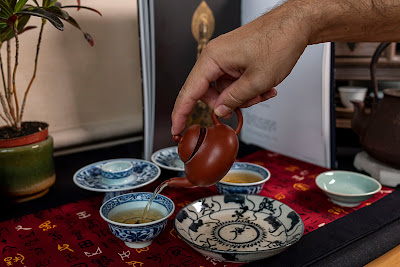Oh joy! The traditional Iron Goddess of Mercy has revealed herself!
This Tie Guan Yin (TGY) Oolong is traditional in every way. It comes from Xi Ping in Anxi in southern Fujian Province. This is the historical birthplace of TGY.
The leaves were harvested by hand from Zheng Jian Tie Guan Yin cultivar tea trees growing on red soil. Zheng Jian means it's not a Sezhong, a substitute for real TGY. Indeed, in Anxi, TGY is so popular that it can also be made from other cultivars like Benshan, Mao Xie, Huang Jing Gui... Here, we have the original cultivar that fits the red heart curved tail description!.(Red hear for red buds and for curved tail see the product description.)
And since the leaves are tightly rolled, I pour with more strength than usual to open up the leaves.
The amber color of the brew is clear and shiny. Divine perfection.
Despite the dark appearance of the dry leaves and their roast scents, the brew is amazingly floral (orchid and magnolia) with ripe fruits in later brews.















No comments:
Post a Comment